| Srl | Item |
| 1 |
ID:
139895


|
|
|
|
|
| Edition |
1st ed.
|
| Publication |
New York, New Benjamin Franklin House, 1985.
|
| Description |
xv, 266p.pbk
|
| Standard Number |
933488432
|
|
|
|
|
|
|
|
|
|
|
|
Copies: C:1/I:0,R:0,Q:0
Circulation
| Accession# | Call# | Current Location | Status | Policy | Location |
| 025864 | 954.052/EDI 025864 | Main | On Shelf | General | |
|
|
|
|
| 2 |
ID:
061857
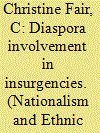

|
|
|
| 3 |
ID:
113792
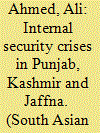

|
|
|
|
|
| Publication |
2010.
|
| Summary/Abstract |
The article argues that the militarised nature of India's initial reaction to an internal security crisis contributes to deterioration in the situation. The resulting full-blown insurgency, usually complicated by proxy war, takes several years to wind down due to the political prong of strategy not keeping pace with the military prong. This is to the detriment of the legitimacy of the state and exacts a high human price. Learning lessons from India's initial reaction to insurgency outbreak therefore helps to highlight the importance of prevention and possibilities in non-militarised alternatives. The article considers the initial phases of three of India's major counter-insurgency engagements-Punjab, Kashmir and in Tamil areas of Sri Lanka-to arrive at the conclusion that moderation in facing crisis prevents conflict outbreak.
|
|
|
|
|
|
|
|
|
|
|
|
|
|
|
|
| 4 |
ID:
093186
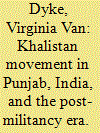

|
|
|
| 5 |
ID:
058386


|
|
|
|
|
| Edition |
1st ed.
|
| Publication |
New Delhi, K.K. Publishers, 1998.
|
| Description |
250p.hbk
|
| Standard Number |
8186912010
|
|
|
|
|
|
|
|
|
|
|
|
Copies: C:1/I:0,R:0,Q:0
Circulation
| Accession# | Call# | Current Location | Status | Policy | Location |
| 044069 | 954.5/GRE 044069 | Main | On Shelf | General | |
|
|
|
|
| 6 |
ID:
073029
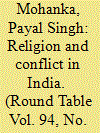

|
|
|
| 7 |
ID:
121107
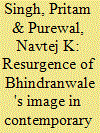

|
|
|
|
|
| Publication |
2013.
|
| Summary/Abstract |
This article will examine the resurgence since 2008 of the public imagery in Punjab of Sant Jarnail Singh Bhindranwale who symbolises a Sikh separatist movement against the Indian state which took shape in the 1980s. The rebellion, characterised in the mainstream urban-based Indian media as an extremist Khalistan movement, had its strongest years of support in the rural areas of Punjab from 1984 until the early 1990s. However, over 25 years later, the symbol of Bhindranwale, who was killed in the Indian army's Operation Blue Star, has re-emerged. The 'bazaar economy' has provided a new canvas for the imagery of Bhindranwale, whose images are today visible in commodified forms available for purchase in shops and market stalls in Punjab. This article analyses this resurgence as a public response to contemporary politics in Punjab and locates the circulation of Bhindranwale through souvenir-like goods within the region's 'economic base of place' (Urry. 1995. Consuming Places. London: Routledge) in which the consumer market has enabled a conduit through which identity and political culture can be both purchased and displayed. The article examines the backdrop of his emblematic re-emergence within the historical context as it relates to the collective memory of 1984 and the meanings of Bhindranwale's legacy and symbolism for the current times.
|
|
|
|
|
|
|
|
|
|
|
|
|
|
|
|